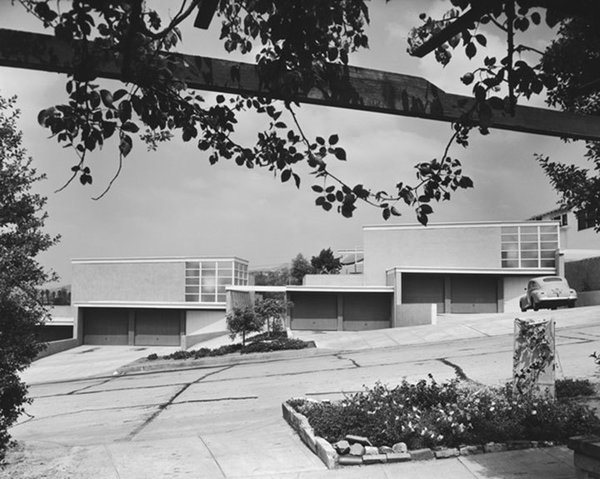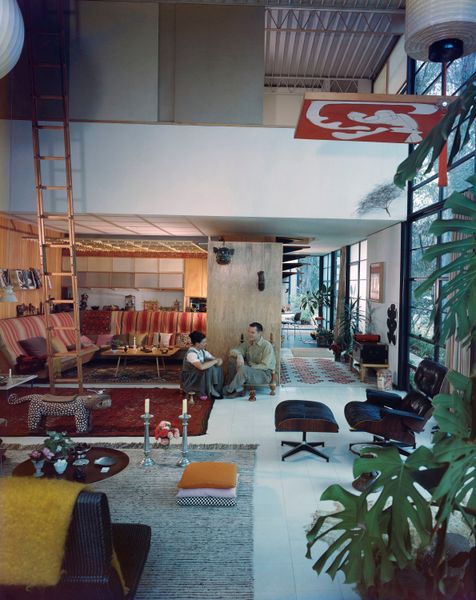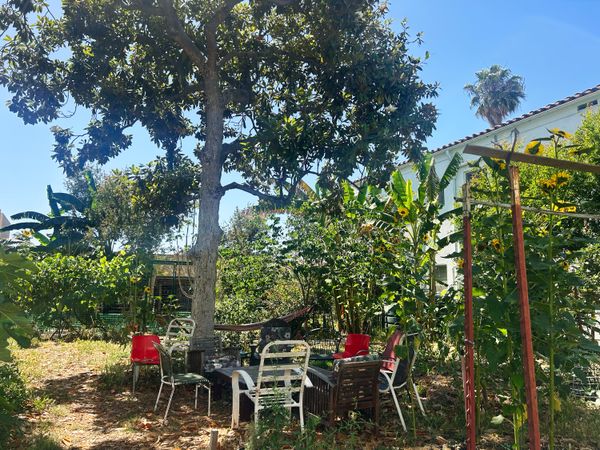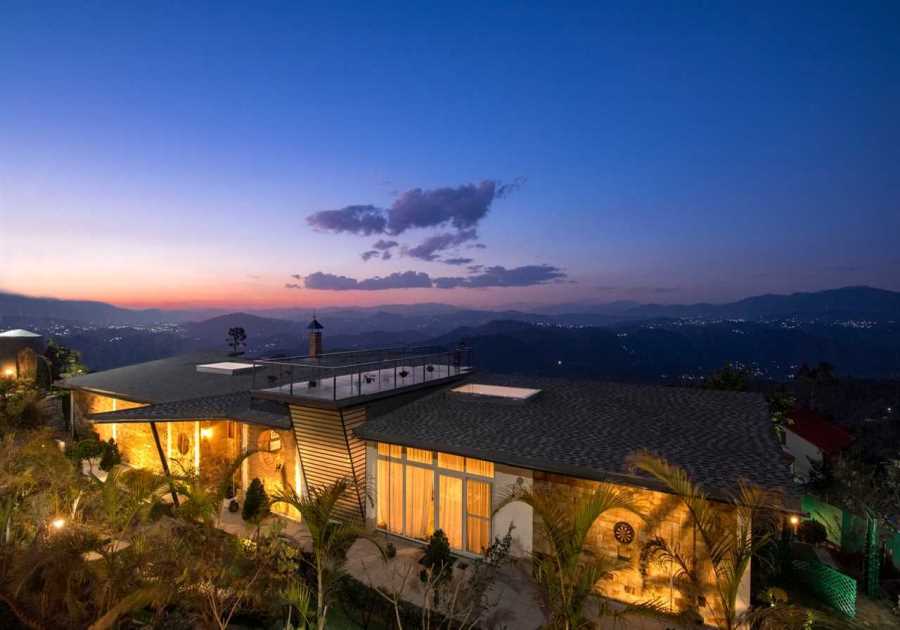If Gregory Ain’s vision for a city filled with housing like his Avenel Cooperative had won out, "we would be in a radically different place."
If there’s one residential architectural style most closely associated with the glitz and glamour of 20th-century Los Angeles, it’s California modernism. Today, midcentury-modern residences dot hills and valleys across the Southland, serving as the perfect backdrops for Palm Springs getaways, movie stars diving into azure pools, and summer ad campaigns.
On one Silver Lake hillside, however, stands an alternative modernist vision that emphasizes not opulence and sprawl, but collective living, density, and affordability. Completed in 1948, and designed by architect Gregory Ain, the Avenel Cooperative is a set of 10 town houses, split across two single-story buildings. The units are all clean lines and California sunshine, with clerestory windows running the length of the buildings’ northern faces and glass walls and picture windows to the south. It’s the kind of geometry whose elegance lies in its simplicity, a distinct characteristic of California modernism.
In 2022, my family bought a unit of the Avenel homes, drawn to both its sleek design and its bold history. It’s no longer a cooperative, and the original owners’ idea of collective decision-making and community ownership has given way to petty squabbles over parking and maintenance in homeowner association meetings. Beneath the peeling paint and leaky roofs, however, lies a historical lesson in what’s possible when we decide to consider housing as a collective rather than individualized pursuit—as well as the constant effort it takes to keep such a bold concept alive. It’s a vision of community rooted in shared space, an ethos 20th-century utopians used to address challenges as diverse as housing affordability, residential segregation, density and walkability, and even child care and care work—one that, six months after the Eaton and Palisades Fires destroyed thousands of homes in the area, has never felt more relevant.

The Avenel Cooperative Housing Project, designed by Gregory Ain, as seen in 1949.
Photo by Julius Shulman. © J. Paul Getty Trust. Getty Research Institute, Los Angeles
An alternative vision for modernism at Avenel
Avenel was commissioned by a group of WWII veterans and their families who, united by their left-wing politics and priced out of single-family lots in the neighborhood, secured Federal Housing Administration loans to hire Ain to design their housing cooperative on a shared plot of land. While new cooperative housing developments are relatively rare today, Avenel was part of a larger movement toward cohousing amid a postwar housing shortage that made traditional stand-alone homes out of reach for many.
A Los Angeles city directory from 1956 gives a sense of the original residents. In the lower building, there was firefighter Finis Sims Jr., who broke the color line as one of the Los Angeles Fire Department’s first Black hires. Next door were sixth-grade teacher and union organizer Serril Gerber in unit 2841.5, and construction worker Carl Brant in unit 2843.
As the Red Scare reached its height in the ’50s, many of Avenel’s residents were investigated and blacklisted for their political beliefs, creating an atmosphere of fear not dissimilar from the federal government’s current attacks on activists, educators, and communities. Gerber was fired by the Los Angeles Board of Education for alleged communist ties, and both he and Brant were called to testify before the House Un-American Activities Committee (HUAC), a Cold-War-era congressional committee tasked with investigating communist and other activities viewed as subversive.
Two actors in the cooperative had their careers cut short after being called before HUAC and appearing on the Hollywood blacklists. One of them, Howland Chamberlin, was allegedly reported to the FBI as a suspected communist by none other than fellow actor Ronald Reagan.
Ain’s design philosophy reflected the political commitments of the original co-op members—and his own socialist politics—by balancing the individual and the collective, says architectural historian Anthony Fontenot, author of Notes from Another Los Angeles: Gregory Ain and the Construction of a Social Landscape. Homeowners entered their units through private entrances on a shared walkway and entertained in their private gardens while their children dug in the sandbox in a shared play yard. Ain went on to build on these ideas in future designs, with plans for developments that included shared gardens, on-site schools and daycares, and park-like spaces for kids to roam without fear of car traffic.
"It’s these ideas that bring people together in subtle ways" across both race and class, says Fontenot. Across all of his major works in Southern California, Ain’s designs allowed residents to "find or develop ways that they might want to not live isolated lives, classically understood as homogenous isolation in the suburbs, but something much more unique where you could build relations and build a larger community."

The Eames House, as seen in 1958.
Photo by Julius Shulman. © J. Paul Getty Trust. Getty Research Institute, Los Angeles
Each of the 960-square-foot units was fitted with sliding walls, allowing residents to modulate their floor plans from one to three bedrooms if needs changed. While some current owners have updated their space with new appliances, fixtures, and furniture, the moving walls remain in place across the 10 units. "To me, this is the ultimate anti-consumerist housing model," says architect Rick Corsini, who has rearranged his living space several times since he moved into Avenel 30 years ago. "It was a bachelor pad, and then I got married, and then we had a kid, and we’ll probably retire and die here."
"He is one of the only architects who has been able to actually—not just claim to—make architecture and design relevant to the working class."
— Anthony Fontenot
Ain was a frequent collaborator with more well-known L.A. modernists, including Charles Eames and John Entenza—until ideological and personality differences sidelined his career. In 1945, Ain was reportedly excluded from Arts & Architecture’s Case Study House Program, which commissioned architects to design model homes, because Entenza, then editor of the magazine, took umbrage at Ain’s commissions for communist clients. The resulting Case Study Homes include exemplars of California modernism, including the Eames House (1949) and the Stahl House (1960). While Entenza’s stated goal for the program was to make high-end design accessible to more consumers at lower costs, the end result did little to make housing more affordable. It did, however, serve as free advertising for the housing industry, furniture retailers, and other makers of consumer products, argues Fontenot in Notes from Another Los Angeles.
If Ain’s vision had ultimately won out, "we would be in a radically different place," says Fontenot. "Southern California and elsewhere would have been able to manifest a more just landscape, a more just kind of city." Instead of neighborhoods segregated along lines of class and race, Fontenot imagines L.A. would be full of affordable, park-like neighborhoods that center around care, connection, and community.
As is, Ain’s ethos wasn’t even enough to keep the Avenel homes affordable. In 1991, Avenel owners voted to convert their cooperative into condominiums. "The argument was, ‘It will be easier to sell these places, and the resale value will be higher,’" explains Corsini, who bought his unit in the first wave of new owners after the vote. Corsini says he bought his unit for $107,000. My family bought our unit for more than 10 times that price three decades later.

USTU’s shared garden.
Photo by Michelle Peng
See the full story on Dwell.com: His Modernist Ideas for L.A. Living Were Dismissed. Now, They Could Be a Blueprint for Rebuilding
Related stories:
- Before & After: They Saved One of the Last Midcentury Homes in Their Lakefront Neighborhood
- An Avid Midcentury Furniture Collector Makes His 1959 Fixer-Upper an Anthology of Modern Design
- A Record Label Cofounder Cues Up a Second Take for a Hollywood Hills Midcentury
Read More
By: Michelle Peng
Title: His Modernist Ideas for L.A. Living Were Dismissed. Now, They Could Be a Blueprint for Rebuilding
Sourced From: www.dwell.com/article/gregory-ain-avenel-housing-cooperative-modernist-affordable-housing-los-angeles-fires-171b97d3-2f1735f5
Published Date: Mon, 14 Jul 2025 15:12:35 GMT
.png)





